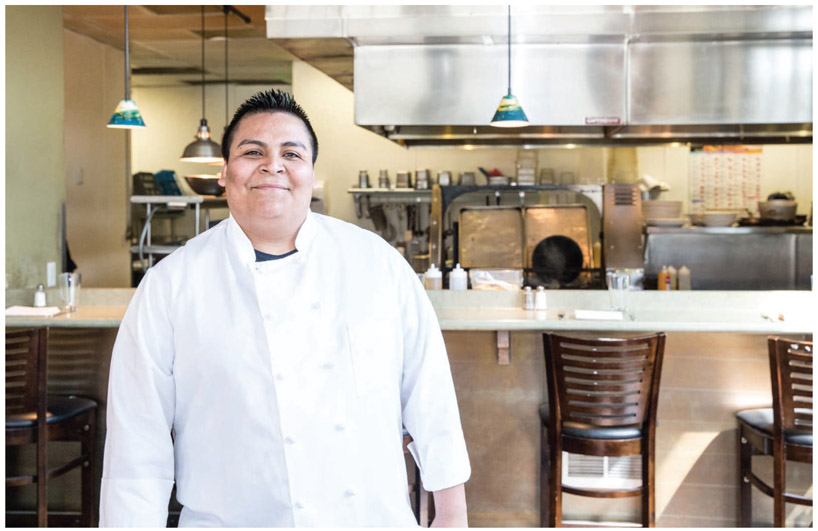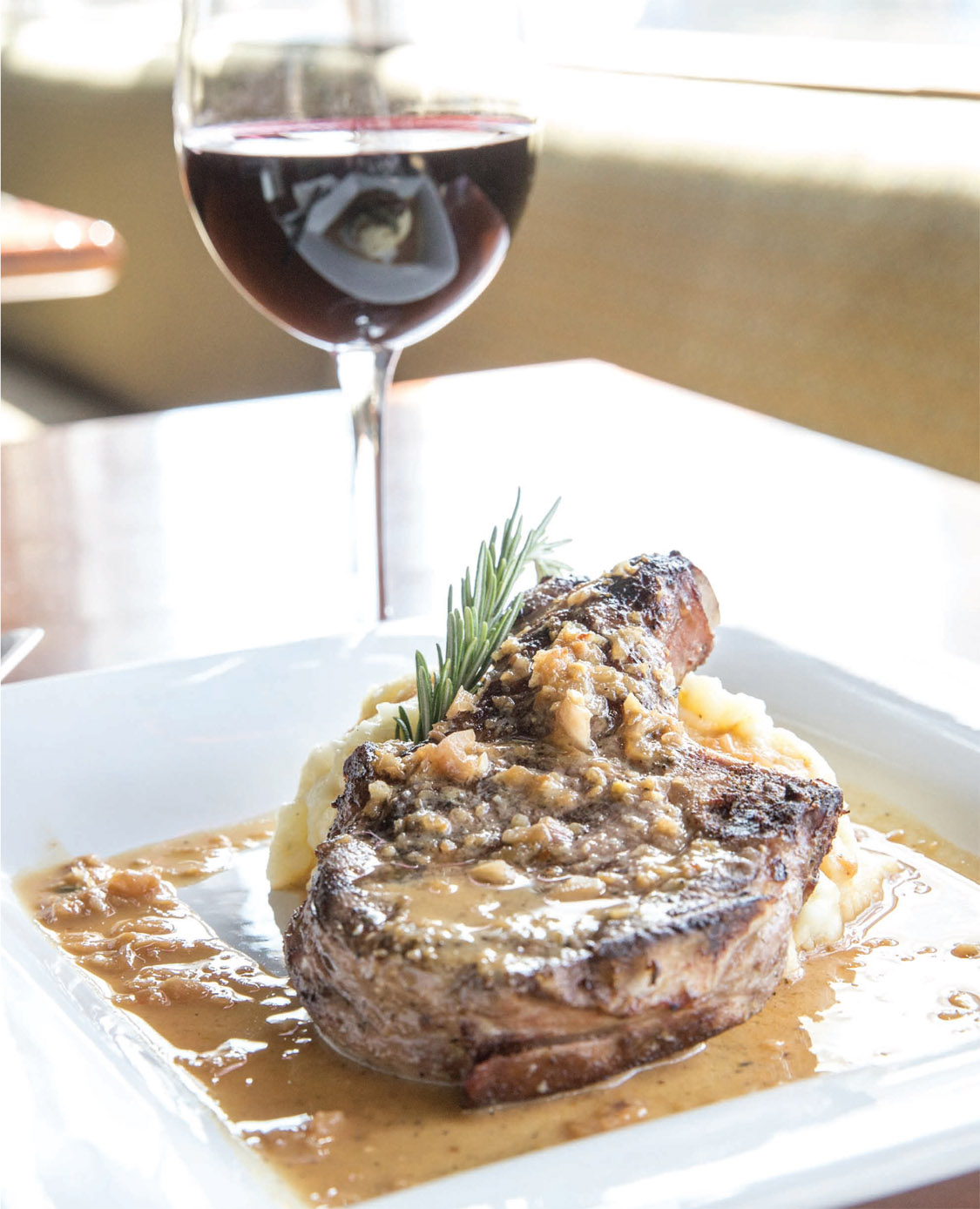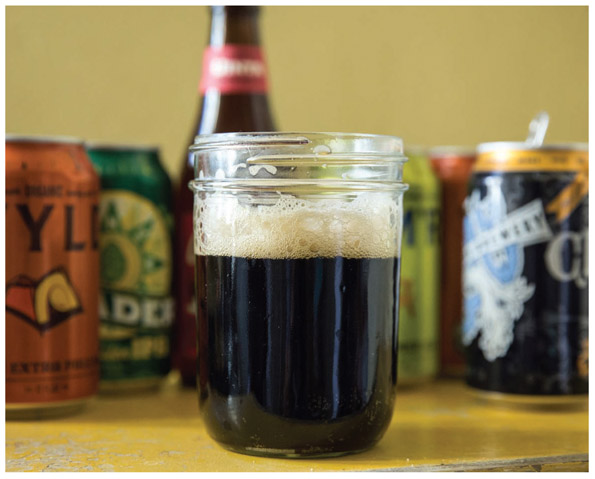
481 EAST SOUTH TEMPLE
SALT LAKE CITY, UTAH 84111
(801) 746-5565
JUAN CARLOS, HEAD CHEF
TROY AND JESSICA GREENHAWT, OWNERS
Troy and Jessica Greenhawt moved into the Avenues Bakery location months after Kathie Chadbourne moved her operation deeper into the throws of the Avenues. After a quick turnaround they opened as Wild Grape in 2009 with an award-winning bartender, Sean Neves (now of Church and State fame), a storied chef in Phelix Gardner (now at Scott Evans’s establishments Finca and Pago), and a measure of goodwill from the community.
Yes, we’re kind of name-dropping a bit here. Wild Grape is the perfect illustration of the small SLC food and beverage scene interweaving. Chefs bounce around from restaurant to restaurant. They’re a nomadic people. Bartenders follow suit. So with every great restaurant and chef comes the influence of another great restaurant and chef.
Current head chef Juan Carlos started washing dishes in the Wild Grape kitchen and learned from some of the talented chefs, most notably Phelix. Juan Carlos joined Phelix at various other endeavors for a stint, eventually finding his way back to Troy’s kitchen, where the two work closely as head chef and general manager. These two collaborate and support each other on everything from what’s on the menu to the kitchen staff.

For Juan Carlos the reward for his time, effort, and passion is simply when someone enjoys his food. If you see his smiling face walking through the restaurant, stop him and tell him what you enjoyed about your food.
While the legacy of past chefs remain, the vibrance of Juan Carlos’s demeanor is now what gives Wild Grape’s kitchen its energy.
(SERVES 4)
For the pork chops:
4 (1½-inch-thick) bone-in pork chops (preferably from the rib end)
2 teaspoons salt
2 teaspoons coarsely ground pepper
½ cup olive oil
For the beer pan sauce:
6 tablespoons butter
2 large shallots (about 1 cup), diced
4 tablespoons brown sugar, packed
2 tablespoons Dijon mustard
2 cups Uinta Dubhe Black IPA (you may use Guinness, Anchor Bock, or your favorite dark beer)
2 teaspoons fresh thyme leaves
To prepare pork chops: Heat a large sauté pan over medium-high heat for 2 minutes or until very hot. Sprinkle one side of each pork chop with salt and pepper. Add the olive oil to the pan and then place the chops in the pan, seasoned side down. Sprinkle the rest of the salt and pepper over the top of the chops. While the pork is cooking, prep the ingredients for the pan sauce. When the bottom of the chops are a nice golden brown, 3–4 minutes, flip them over and cook the other side for 3–4 minutes for medium; thicker chops will be medium-rare. Transfer to a plate and let the chops rest while you make the sauce. Tent the chops with foil while resting if you want them more well done.
To prepare beer pan sauce: Heat the same pan to high heat and add the butter, swirling to melt. Add the shallots and stir, scraping up all the bits from the bottom of the pan. Sauté the shallots for 2 minutes or until golden and translucent. Add the brown sugar and whisk to melt. Add the Dijon mustard and whisk again. Add the beer and fresh thyme leaves. Cook the sauce for 1 minute, whisking while the sauce gently boils. This will help thicken the sauce. Turn the heat off.
To serve: Transfer the chops to a serving platter and spoon beer pan sauce over the top. Serve the remaining sauce on the side. Plate with your favorite vegetables and/or potatoes.

BREWERIES
Quantity is perhaps the poorest measure of quality. Utah’s breweries may be few, but no drop is wasted on substandard swill. Don’t let the number of local microbreweries fool you; Utah’s bars and breweries boast damn good beer. And don’t let the 3.2 percent ABW limitation on grocery store beer get you down. A beer overlooked due to low alcohol content only shows the ignorance of the consumer and offers no commentary on the beer itself. In the same way that a larger number of breweries in Utah does little to validate the existing breweries, so does higher alcohol. Good beer has always been about one thing: good beer.
The state of beer in Utah is good and is swinging ever upward, but only after decades of significant downturn. For there to have been downturn means that at one point, breweries in Utah enjoyed a surprising heyday. Ironically, at one time Utah housed one of the largest breweries in the United States, Salt Lake City Brewing, owned and operated by Jacob Moritz. The Mormon faith once allowed consumption of alcohol for worthy members of the church, and thus a few early breweries were owned and supported by Mormons. In 1921 the LDS church made adherence to the Word of Wisdom necessary for Temple entry, ending the period of feast for the local brewing industry. Surprisingly, Utah voted to repeal Prohibition in December 1933. Its vote was the last needed to pass the measure. High West celebrates Utah’s contribution to the end of Prohibition with a barrel-aged Manhattan appropriately named The 36th Vote.
Post-Prohibition and Word of Wisdom limitations in the market presented challenges that were eventually insurmountable. In 1967 Fisher Brewing, the only brewery in Utah at the time, closed its doors, beginning a prohibition of a different style for the next nineteen years.
Enter Greg Schirf. He paved the way and opened the doors for the scene that locals enjoy so much now. Greg worked to legalize the brewpub concept already prevalent elsewhere by working with a senator from Price, Utah, of all places. The opening of Schirf Brewing Company (eventually Wasatch Brewing) marked the end of a nineteen-year drought in brewing on Utah soil.
Wasatch formed a cooperative with Squatters Pub Brewery in 2000, called the Utah Brewers Cooperative, which eventually led to combining their breweries and bottling operations at 1763 South 300 West. While both maintain their respective brands and brews, everything else operates under one roof.
Thanks to Schirf’s efforts, Red Rock Brewing began as a brewpub in the heart of downtown near the convention center, where it enjoys a packed house on a regular basis. In 2000 Brewpub Magazine named Red Rock the brewpub of the year, memorializing a change in Utah in front of the national scene. To boot, the Great American Beer Festival named Red Rock the Large Brewpub of the Year in 2007. Not only does Utah have brewpubs, but they’re also the best brewpubs in the country.
After enjoying more than a hundred awards for its in-house brews, Red Rock made the jump out of the house and started bottling high-point beers, something the brewpub could never offer thanks to the 3.2 restrictions. Among some pretty incredible bottled beer, the Elephino scored an 87 by Beer Advocate and continually proves to be a favorite among hops lovers in Salt Lake.
In 1993 Uinta Brewing started brewing beers exclusively for wholesale. With no designs on a brewpub or restaurant, Uinta pushed hard to make Utah proud by brewing consistently good 3.2 beer. Walk the massive brewing facility in Salt Lake and you’ll be blown away that something of this size is still called a “micro” brewery. But owner Steve Kuftinec is quick to point out that Coors Brewing produces more in one day than Unita produces in a year.
Uinta became something that had not existed since the early years of the twentieth century: a significant brewery that makes waves beyond Utah’s borders. Inside Utah, the famous Cutthroat Pale Ale has, since the beginning, been the best-selling Uinta beer. But beyond our borders, the Hop Nosh (formerly Hop Notch) put Utah on the radar of IPA enthusiasts around the country. In 2013 Hop Nosh surpassed Cutthroat for the first time as Uinta’s best seller.
Epic Brewing came on the brewing scene and proved that high-point beer in Utah is a successful model for making highly desirable beer and plenty of money. All Epic brews are twenty-two-ounce high-point beers meant to be shared with a friend or finished after a long day.

There are some pretty clear limitations with Epic’s model that should have certainly led to their demise. First, only 3.2 beer can be sold in grocery stores. Most people buy beer at the grocery store. That’s a clear advantage to breweries like Uinta that do 3.2 really well. Second, the bottles are huge by comparison to the standard twelve-ounce bottles that normally define the single-serving size. And third, they’re new to a market with a lot of loyalty to the present breweries.
In the face of these few disadvantages, Epic sold out of their entire production the first week they were open, quickly proving that Utah’s pulse is changing. Epic’s success most clearly tells the story of Utah as it exists today. The total number of beer drinkers is on the rise, and they are willing to pay more for beer and drink beer at higher points.
Every brewery in some way shows the pioneer spirit of Utah. Each one offers something just different enough to build a fan base to support itself. From the days of Moritz and Salt Lake Brewing to Schirf’s pioneering work and the reawakening of Utah’s once massive beer scene, the condition of beer in Utah is strong.